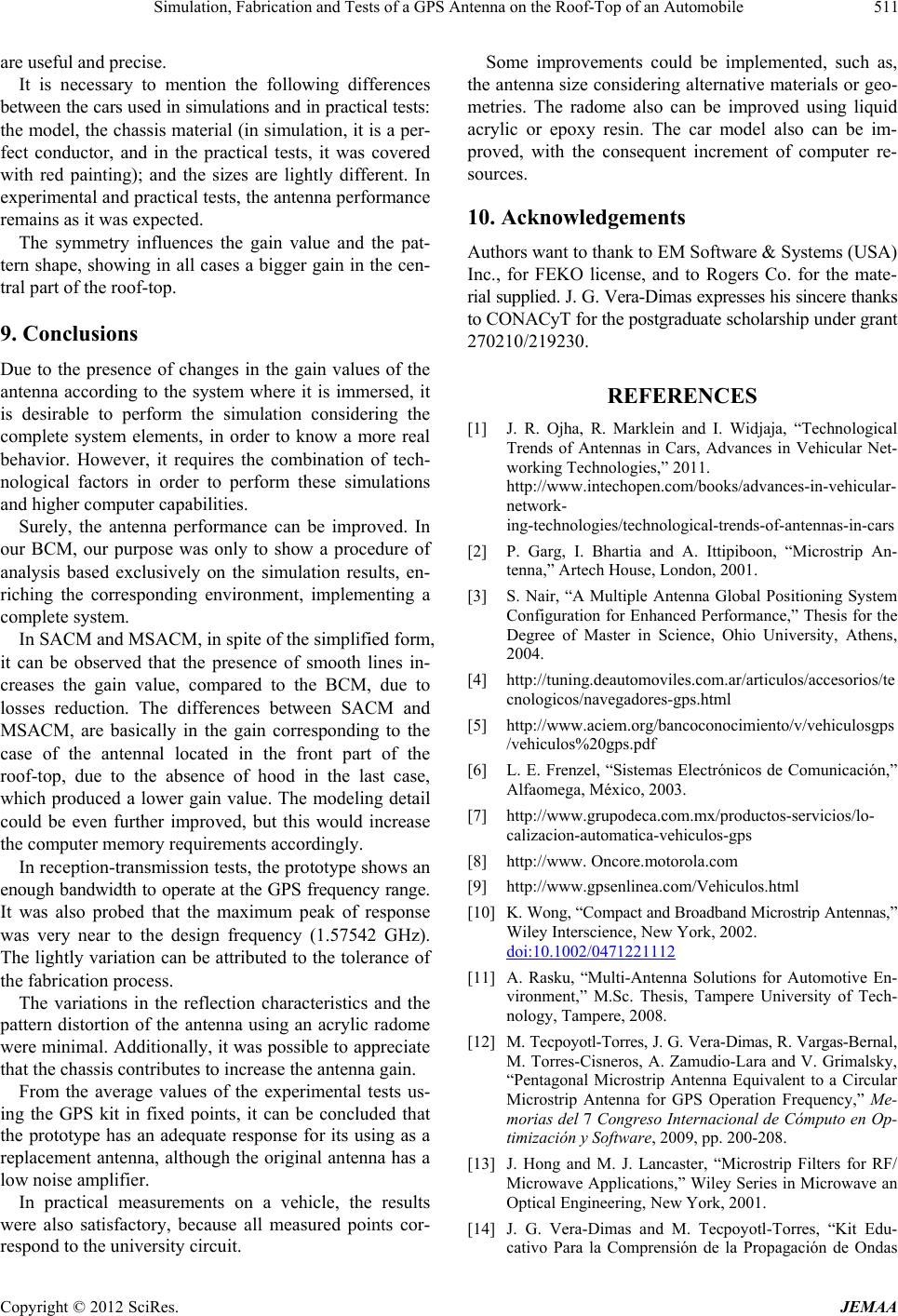
Simulation, Fabrication and Tests of a GPS Antenna on the Roof-Top of an Automobile 511
are useful and precise.
It is necessary to mention the following differences
between the cars used in simulations and in practical tests:
the model, the chassis material (in simulation, it is a per-
fect conductor, and in the practical tests, it was covered
with red painting); and the sizes are lightly different. In
experimental and practical tests, the antenna performance
remains as it was expected.
The symmetry influences the gain value and the pat-
tern shape, showing in all cases a bigger gain in the cen-
tral part of the roof-top.
9. Conclusions
Due to the presence of changes in the gain values of the
antenna according to the system where it is immersed, it
is desirable to perform the simulation considering the
complete system elements, in order to know a more real
behavior. However, it requires the combination of tech-
nological factors in order to perform these simulations
and higher computer capabilities.
Surely, the antenna performance can be improved. In
our BCM, our purpose was only to show a procedure of
analysis based exclusively on the simulation results, en-
riching the corresponding environment, implementing a
complete system.
In SACM and MSACM, in spite of the simplified form,
it can be observed that the presence of smooth lines in-
creases the gain value, compared to the BCM, due to
losses reduction. The differences between SACM and
MSACM, are basically in the gain corresponding to the
case of the antennal located in the front part of the
roof-top, due to the absence of hood in the last case,
which produced a lower gain value. The modeling detail
could be even further improved, but this would increase
the computer memory requirements accordingly.
In reception-transmission tests, the prototype shows an
enough bandwidth to operate at the GPS frequency range.
It was also probed that the maximum peak of response
was very near to the design frequency (1.57542 GHz).
The lightly variation can be attributed to the tolerance of
the fabrication process.
The variations in the reflection characteristics and the
pattern distortion of the antenna using an acrylic radome
were minimal. Additionally, it was possible to appreciate
that the chassis contributes to increase the antenna gain.
From the average values of the experimental tests us-
ing the GPS kit in fixed points, it can be concluded that
the prototype has an adequate response for its using as a
replacement antenna, although the original antenna has a
low noise amplifier.
In practical measurements on a vehicle, the results
were also satisfactory, because all measured points cor-
respond to the university circuit.
Some improvements could be implemented, such as,
the antenna size considering alternative materials or geo-
metries. The radome also can be improved using liquid
acrylic or epoxy resin. The car model also can be im-
proved, with the consequent increment of computer re-
sources.
10. Acknowledgements
Authors want to thank to EM Software & Systems (USA)
Inc., for FEKO license, and to Rogers Co. for the mate-
rial supplied. J. G. Vera-Dimas expresses his sincere thanks
to CONACyT for the postgraduate scholarship under grant
270210/219230.
REFERENCES
[1] J. R. Ojha, R. Marklein and I. Widjaja, “Technological
Trends of Antennas in Cars, Advances in Vehicular Net-
working Technologies,” 2011.
http://www.intechopen.com/books/advances-in-vehicular-
network-
ing-technologies/technological-trends-of-antennas-in-cars
[2] P. Garg, I. Bhartia and A. Ittipiboon, “Microstrip An-
tenna,” Artech House, London, 2001.
[3] S. Nair, “A Multiple Antenna Global Positioning System
Configuration for Enhanced Performance,” Thesis for the
Degree of Master in Science, Ohio University, Athens,
2004.
[4] http://tuning.deautomoviles.com.ar/articulos/accesorios/te
cnologicos/navegadores-gps.html
[5] http://www.aciem.org/bancoconocimiento/v/vehiculosgps
/vehiculos%20gps.pdf
[6] L. E. Frenzel, “Sistemas Electrónicos de Comunicación,”
Alfaomega, México, 2003.
[7] http://www.grupodeca.com.mx/productos-servicios/lo-
calizacion-automatica-vehiculos-gps
[8] http://www. Oncore.motorola.com
[9] http://www.gpsenlinea.com/Vehiculos.html
[10] K. Wong, “Compact and Broadband Microstrip Antennas,”
Wiley Interscience, New York, 2002.
doi:10.1002/0471221112
[11] A. Rasku, “Multi-Antenna Solutions for Automotive En-
vironment,” M.Sc. Thesis, Tampere University of Tech-
nology, Tampere, 2008.
[12] M. Tecpoyotl-Torres, J. G. Vera-Dimas, R. Vargas-Bernal,
M. Torres-Cisneros, A. Zamudio-Lara and V. Grimalsky,
“Pentagonal Microstrip Antenna Equivalent to a Circular
Microstrip Antenna for GPS Operation Frequency,” Me-
morias del 7 Congreso Internacional de Cómputo en Op-
timización y Software, 2009, pp. 200-208.
[13] J. Hong and M. J. Lancaster, “Microstrip Filters for RF/
Microwave Applications,” Wiley Series in Microwave an
Optical Engineering, New York, 2001.
[14] J. G. Vera-Dimas and M. Tecpoyotl-Torres, “Kit Edu-
cativo Para la Comprensión de la Propagación de Ondas
Copyright © 2012 SciRes. JEMAA